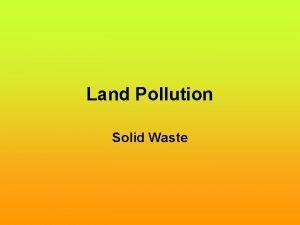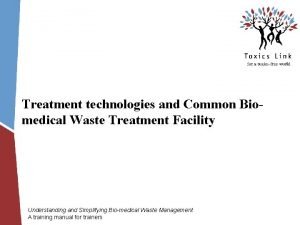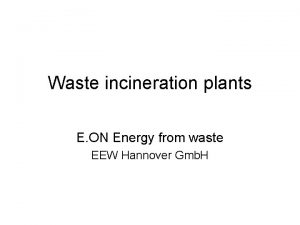What is Incineration incineration is a waste treatment







- Slides: 7

What is Incineration • • incineration is a waste treatment process that involves the combustion of organic substances contained in waste materials. Incineration of waste materials converts the waste into ash, flue gas, and heat. Incineration with energy recovery is one of several waste-to-energy (WTE) technologies. The way this is done is by converting generated steam into electricity and heat. Incineration plant means any stationary or mobile technical unit and equipment dedicated to thermal treatment of wastes with or without recovery of the combustion heat generated. This includes the incineration by oxidation of waste as well as othermal treatment processes such as pyrolysis, gasification or plasma processes in so far as the substances resulting from the treatment are subsequently incinerated. (2000/76/EC definition)


Arguments for Incinerators • • The mass of the waste can be reduced by up to 85%. Many incinerators reach temperatures which can destroy most harmful pathogens and chemicals, which is why this method is used for dealing with clinical waste Incineration of domestic and industrial waste can be used to produce energy in the form of electricity and also heat which can be piped to municipal heating schemes. In this way some use is being made of the heat being created when burning the waste. Electricity generated from a typical 100, 000 tpa facility would be roughly equivalent to the electricity usage of 20, 000 households and would be exported to the national grid. Modern incinerator technology is able to filter out many of the potential harmful emissions so that they do not escape into the outside environment. These include various dioxins, particulates and some environmentally dangerous acidic gases like hydrogen chloride.

Arguments against • • • Unless important resources such as all metals, plastics, and glass are removed before incineration this process can result in loss of resources The use of incineration to deal with waste can also be a disincentive to use and promote recycling schemes and to compost organic household waste at a municipal level. This issue can be further exacerbated by the fact that the high costs of building an incinerator need to be offset with long contracts with municipal authorities to burn local waste or waste from other regions. The location of an incinerator is often very controversial. The reasons cited are: 1) they can bring include increased traffic to an area, which can be prevented with the use of t heir own railway system 2)Unpleasant smells and an adverse effect on local land house prices. This latter effect could just be perception They still do not filter out the smallest particles. Some of these particles are unregulated by air quality standards and it Is not clear whether they cause any health problems. This gives incinerator companies blank scope to emit them. Very costly if intention is to run it as safe as it can be.



References: • • http: //www. seas. columbia. edu/earth/wtert/index. html http: //www. wtert. com. br/home 2010/arquivo/publicacoes/3872. pdf http: //www. ecoants. com/wasteincineration. html www. terryally. com/library/199703 incineration. html












